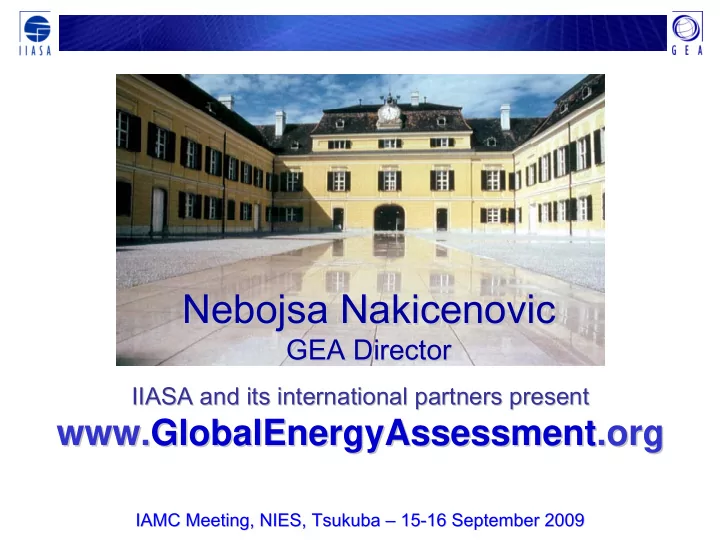

Nebojsa Nakicenovic Nebojsa Nakicenovic GEA Director GEA Director IIASA IIASA IIASA and its international partners present IIASA and its international partners present International Institute for Applied Systems Analysis International Institute for Applied Systems Analysis www.GlobalEnergyAssessment GlobalEnergyAssessment.org .org www. IAMC Meeting, NIES, Tsukuba NIES, Tsukuba – 15- -16 September 2009 16 September 2009 IAMC Meeting, – 15
Need for an Energy Assessment Need for an Energy Assessment ● The world is at a critical juncture for energy ● The world is at a critical juncture for energy policy, new challenges have emerged, while policy, new challenges have emerged, while old ones remain old ones remain ● Previous studies do not identify the ● Previous studies do not identify the strategies and solutions needed to strategies and solutions needed to today’ ’s major s major address today comprehensively address comprehensively energy and energy- -related challenges in an related challenges in an energy and energy way integrated way integrated
GEA Objectives include: GEA Objectives include: ● ● Science based, comprehensive, integrated, and Science based, comprehensive, integrated, and analysis of issues and options relevant analysis of issues and options policy- -relevant policy related to: related to: – Energy and sustainability challenges – Energy and sustainability challenges – Resource and technology options, demand and – Resource and technology options, demand and supply supply – System issues, scenarios – System issues, scenarios – Policy options – Policy options ● Local, Regional, and Global dimensions ● Local, Regional, and Global dimensions
integration of knowledge clusters integration of knowledge clusters ● ● Cluster I characterizes nature and characterizes nature and magnitude magnitude of challenges, of challenges, Cluster I and express them in selected indicators and express them in selected indicators ● reviews existing and future resource and technology ● Cluster II reviews existing and future resource and technology Cluster II options options ● cluster II elements into systems, and links ● integrates cluster II elements into systems, and links Cluster III integrates Cluster III these to indicators from Cluster I these to indicators from Cluster I ● This will include energising of rural areas, land use, water, ● This will include energising of rural areas, land use, water, urbanisation, life- urbanisation, life -styles, etc. styles, etc. ● ● Scenarios, using numerical models and storylines, will be used Scenarios, using numerical models and storylines, will be used for the integration , in an iterative fashion for the integration , in an iterative fashion ● assesses policy options, and specifically identifies ● Cluster IV assesses policy options, and specifically identifies Cluster IV that are linked to scenarios meeting the policy packages that are linked to scenarios meeting the policy packages needs, again in an iterative fashion. needs, again in an iterative fashion.
Main Transition Strategies ● End-use and efficiency focus with contribution of supply GEA-Low (Di- Ana) ● Supply-side focus with contribution of efficiency GEA-High (Anan-D) ● Balanced contributions of measures GEA-Mid (Kir-K) ● Overall socioeconomic development goals are met in all scenarios (intermediate population & GDP)
“GEA-L” Di-Ana Demand-side & behavioral change Supply-side change
“GEA-H” Anan-D Demand-side & behavioral change Supply-side change
“GEA-M” Kir-K Demand-side & behavioral change Balanced Approach Supply-side change
CO 2 Emissions Reductions GEA-L 15.0 12.5 Demand 10.0 (tech + behavior) 7.5 GtC/yr Fossil CCS 5.0 Nuclear 2.5 Renewables 0.0 + Bio-CCS -2.5 -5.0 2005 2010 2020 2030 2040 2050 2060 2070 2080 2090 2100
Trade-offs and Synergies Focus Security and Climate Change Objectives ● Aim to explore policy trade-offs and synergies: – different temporal scales – alternative objectives – Requires multi-objective analysis ● Scenario sensitivity analysis for a combination of different targets for: – Short-term GHG and pollutant emissions – Long-term climate target (probability of staying below 2C) – Short-term security targets (limiting regional trade) ● Multi-criteria optimization
www.GlobalEnergyAssessment.org Towards a more Sustainable Future ● The magnitude of the change required in the global energy system will be huge ● The challenge is to find a way forward that addresses simultaneously climate change, security, equity and economics issues. ● Paradigm change is needed : radical improvements in energy end-use efficiency, new renewables, advanced nuclear and carbon capture and storage. ● Needs to be globally integrated but with maximum support of countries and local levels. ● In the best spirit of science: fact-based and peer- reviewed 11
Confronting the Challenges of Energy for Confronting the Challenges of Energy for Sustainable Development: Sustainable Development: The Role of Scientific and Technical Analysis The Role of Scientific and Technical Analysis IIASA IIASA International Institute for Applied Systems Analysis International Institute for Applied Systems Analysis and its international partners present and its international partners present www.GlobalEnergyAssessment GlobalEnergyAssessment.org .org www.
Recommend
More recommend